花色苷(书籍文献)Anthocyanins,Kevin Gould · Kevin Davies · Chris Winefield,Biosynthesis, Functions, and Applications
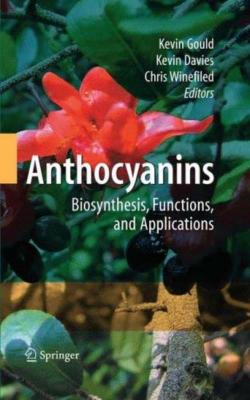
Kevin Gould Kevin Davies Chris Winefiled Editors Anthocyanins Biosynthesis,Functions, and Applications ②Springer
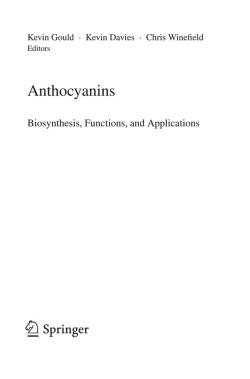
Kevin Gould·Kevin Davies·Chris Winefield Editors Anthocyanins Biosynthesis,Functions,and Applications ②Springer
Kevin Gould · Kevin Davies · Chris Winefield Editors Anthocyanins Biosynthesis, Functions, and Applications 123
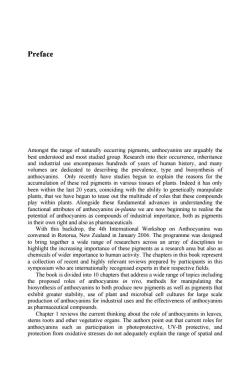
Preface at the range of natrly occurring Pigments anihoeyanins sare arguably the nd mo st stu ed grou into the edicated ribin stu of variou r pla L e last 20 y play in fun I advan f attributes of anthocyanins n-planta we are now beginn g to realise the potential I of anthocyanins as compounds of industrial importance,both as pigments in their own right and also as pharmaceuticals. With this backdrop,the 4th International Workshop on Anthocyanins was convened in Rotorua,New Zealand in January 2006.The programme was designed to bring together a wide range of researchers across an array of disciplines to highlight the increasing importance of these pigments as a research area but also as chemicals of wider importance to human activity.The chapters in this book represent a collection of recent and highly relevant reviews prepared by participants in this symposium who are internationally recognised experts in their respective fields The book is divided into 10 chapters that address a wide range of topics including the proposed roles of anthocyanins in vivo,methods for manipulating the biosynthesis of anthocyanins to both produce new pigments as well as pigments that exhibit greater stability,use of plant and microbial cell cultures for large scale production of anthocyanins for industrial uses and the effectiveness of anthocyanins as pharmaceutical compounds. Chapter I reviews the current thinking about the role of anthocyanins in leaves stems roots and other vegetative organs.The authors point out that current roles for anthocyanins such as participation in photoprotective.UV-B protective.and protection from oxidative stresses do not adequately explain the range of spatial and
Preface Amongst the range of naturally occurring pigments, anthocyanins are arguably the best understood and most studied group. Research into their occurrence, inheritance and industrial use encompasses hundreds of years of human history, and many volumes are dedicated to describing the prevalence, type and biosynthesis of anthocyanins. Only recently have studies begun to explain the reasons for the accumulation of these red pigments in various tissues of plants. Indeed it has only been within the last 20 years, coinciding with the ability to genetically manipulate plants, that we have begun to tease out the multitude of roles that these compounds play within plants. Alongside these fundamental advances in understanding the functional attributes of anthocyanins in-planta we are now beginning to realise the potential of anthocyanins as compounds of industrial importance, both as pigments in their own right and also as pharmaceuticals. With this backdrop, the 4th International Workshop on Anthocyanins was convened in Rotorua, New Zealand in January 2006. The programme was designed to bring together a wide range of researchers across an array of disciplines to highlight the increasing importance of these pigments as a research area but also as chemicals of wider importance to human activity. The chapters in this book represent a collection of recent and highly relevant reviews prepared by participants in this symposium who are internationally recognised experts in their respective fields. The book is divided into 10 chapters that address a wide range of topics including the proposed roles of anthocyanins in vivo, methods for manipulating the biosynthesis of anthocyanins to both produce new pigments as well as pigments that exhibit greater stability, use of plant and microbial cell cultures for large scale production of anthocyanins for industrial uses and the effectiveness of anthocyanins as pharmaceutical compounds. Chapter 1 reviews the current thinking about the role of anthocyanins in leaves, stems roots and other vegetative organs. The authors point out that current roles for anthocyanins such as participation in photoprotective, UV-B protective, and protection from oxidative stresses do not adequately explain the range of spatial and
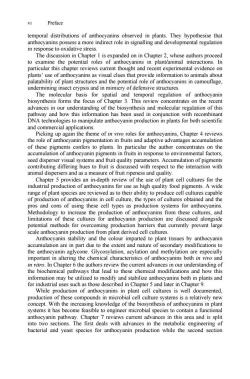
vi Preface temporal distributions of anthocyanins observed in plants.They hypothesise tha anthocyanins pos s a more indirect role in signalling and developmental regulation in response to oxidative stress The discussion in Chapter I is expanded on in Chapter 2,whose authors proceed to examine the potential roles of anthocyanins in plant/animal interactions.In particular this chapter reviews current thought and recent experimental evidence on plants use of anthocyanins as visual clues that provide information to animals about palatability of plant structures and the potential role of anthocyanins in camouflage, undermining insect crypsis and in mimicry of defensive structures. The molecular basis for spatial and temporal regulation of anthocyanin biosynthesis forms the focus of Chapter 3.This review concentrates on the recent advances in our understanding of the biosynthesis and molecular regulation of this pathway and how this information has been used in conjunction with recombinant DNA technologies to manipulate anthocvanin production in plants for both scientific and commercial applications. Picking up again the theme of in vivo roles for anthocyanins,Chapter 4 reviews the role of anthocyanin pigmentation in fruits and adaptive advantages accumulation of these pigments confers to plants.In particular the author concentrates on the accumulation of anthocyanin pigments in fruits in response to environmental factors, seed disperser visual systems and fruit quality parameters.Accumulation of pigments contributing differing hues to fruit is discussed with respect to the interaction with animal dispersers and as a measure of fruit ripeness and quality Chapter 5 provides an in-depth review of the use of plant cell cultures for the range of plant species are reviewed as to their ability to cultures capable of production of anthocvanins in cell culture.the typ s obtained and the pros and cons of using these cell types as produd ion systems for anthocvanins Methodology to inc rease the production anthocvanins from these and limitations of these cultures for antho anin production are discussed potential methods for overcoming production barriers that currently prevent large scale anthoc oduction from m plant der ived cell cult Anthoc stability and the mp cd to tissues by are due to y mo ficatio ethyla espe che th the ter pter emic that d ew an n m nts and While des p of yan ture a relat With the inc ge of t nthes feasible to engineer of anth systems it has r mi ontain a anthocyanin pathway.Chapter rev ws current adva ces in this area and is spl into two sections.The first deals with advances in the metabolic engineering of bacterial and yeast species for anthocyanin production while the second section
vi Preface temporal distributions of anthocyanins observed in plants. They hypothesise that anthocyanins possess a more indirect role in signalling and developmental regulation in response to oxidative stress. The discussion in Chapter 1 is expanded on in Chapter 2, whose authors proceed to examine the potential roles of anthocyanins in plant/animal interactions. In particular this chapter reviews current thought and recent experimental evidence on plants’ use of anthocyanins as visual clues that provide information to animals about palatability of plant structures and the potential role of anthocyanins in camouflage, undermining insect crypsis and in mimicry of defensive structures. The molecular basis for spatial and temporal regulation of anthocyanin biosynthesis forms the focus of Chapter 3. This review concentrates on the recent advances in our understanding of the biosynthesis and molecular regulation of this pathway and how this information has been used in conjunction with recombinant DNA technologies to manipulate anthocyanin production in plants for both scientific and commercial applications. Picking up again the theme of in vivo roles for anthocyanins, Chapter 4 reviews the role of anthocyanin pigmentation in fruits and adaptive advantages accumulation of these pigments confers to plants. In particular the author concentrates on the accumulation of anthocyanin pigments in fruits in response to environmental factors, seed disperser visual systems and fruit quality parameters. Accumulation of pigments contributing differing hues to fruit is discussed with respect to the interaction with animal dispersers and as a measure of fruit ripeness and quality. Chapter 5 provides an in-depth review of the use of plant cell cultures for the industrial production of anthocyanins for use as high quality food pigments. A wide range of plant species are reviewed as to their ability to produce cell cultures capable of production of anthocyanins in cell culture, the types of cultures obtained and the pros and cons of using these cell types as production systems for anthocyanins. Methodology to increase the production of anthocyanins from these cultures, and limitations of these cultures for anthocyanin production are discussed alongside potential methods for overcoming production barriers that currently prevent large scale anthocyanin production from plant derived cell cultures. Anthocyanin stability and the colour imparted to plant tissues by anthocyanin accumulation are in part due to the extent and nature of secondary modifications to the anthocyanin aglycone. Glycosylation, acylation and methylation are especially important in altering the chemical characteristics of anthocyanins both in vivo and in vitro. In Chapter 6 the authors review the current advances in our understanding of the biochemical pathways that lead to these chemical modifications and how this information may be utilized to modify and stabilize anthocyanins both in plants and for industrial uses such as those described in Chapter 5 and later in Chapter 9. While production of anthocyanins in plant cell cultures is well documented, production of these compounds in microbial cell culture systems is a relatively new concept. With the increasing knowledge of the biosynthesis of anthocyanins in plant systems it has become feasible to engineer microbial species to contain a functional anthocyanin pathway. Chapter 7 reviews current advances in this area and is split into two sections. The first deals with advances in the metabolic engineering of bacterial and yeast species for anthocyanin production while the second section
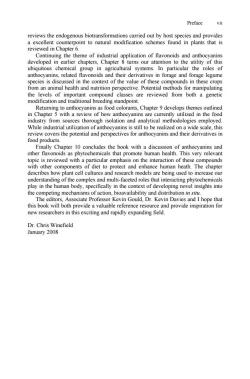
Preface vii reviews the endogenous biotransformations carried out by host species and provides a excellent counterpoint to natural modification schemes found in plants that is reviewed in Chapter 6. Continuing the theme of industrial application of flavonoids and anthocyanins developed in earlier chapters,Chapter 8 turns our attention to the utility of this ubiquitous chemical group in agricultural systems.In particular the roles of anthocyanins,related flavonoids and their derivatives in forage and forage legume species is discussed in the context of the value of these compounds in these crops from an animal health and nutrition perspective.Potential methods for manipulating the levels of important compound classes are reviewed from both a genetic modification and traditional breeding standpoint. Returning to anthocyanins as food colorants.Chapter 9 develops themes outlined in Chapter 5 with a review of how anthocvanins are currently utilized in the food industry from sources thorough isolation and analytical methodologies employed While industrial utilization of anthocvanins is still to be realized on thi potential and food products. mally Chapter 10 concludes the book with a discussion of anthocyanins and other flavonoids as phyto hemicals that note hur ver is reviewed prom cula a pa emp and uman ell cul chap ease ou d rsta mplex mult aceted roles t t interacting phytoche novel insights into the compe ioavailal tion in s ciat Kevin Gould, andIhope th th provide a valuable re erence resource and provide inspiration for new researchers in this exciting and rapidly expanding field. Dr.Chris Winefield January 2008
Preface vii reviews the endogenous biotransformations carried out by host species and provides a excellent counterpoint to natural modification schemes found in plants that is reviewed in Chapter 6. Continuing the theme of industrial application of flavonoids and anthocyanins developed in earlier chapters, Chapter 8 turns our attention to the utility of this ubiquitous chemical group in agricultural systems. In particular the roles of anthocyanins, related flavonoids and their derivatives in forage and forage legume species is discussed in the context of the value of these compounds in these crops from an animal health and nutrition perspective. Potential methods for manipulating the levels of important compound classes are reviewed from both a genetic modification and traditional breeding standpoint. Returning to anthocyanins as food colorants, Chapter 9 develops themes outlined in Chapter 5 with a review of how anthocyanins are currently utilized in the food industry from sources thorough isolation and analytical methodologies employed. While industrial utilization of anthocyanins is still to be realized on a wide scale, this review covers the potential and perspectives for anthocyanins and their derivatives in food products. Finally Chapter 10 concludes the book with a discussion of anthocyanins and other flavonoids as phytochemicals that promote human health. This very relevant topic is reviewed with a particular emphasis on the interaction of these compounds with other components of diet to protect and enhance human heath. The chapter describes how plant cell cultures and research models are being used to increase our understanding of the complex and multi-faceted roles that interacting phytochemicals play in the human body, specifically in the context of developing novel insights into the competing mechanisms of action, bioavailability and distribution in situ. The editors, Associate Professor Kevin Gould, Dr. Kevin Davies and I hope that this book will both provide a valuable reference resource and provide inspiration for new researchers in this exciting and rapidly expanding field. Dr. Chris Winefield January 2008

Contents Preface. Contributors.. ..xvii 1 Anthocvanin function in vegetative organs Jean-Hugues B.Hatier and Kevin S.Gould 1.1 Introduction. 12 Anthocvanins and Stress Responses. 13 Photoprotection」 1 4 Prote ction Ag nst ultraviolet radiation 15 16 Paradigm Shift 10 17 Modulatio n of Signalling Cascades:A New Hypothesis References. 2. 21 Le n and Kevin S.Gould 123 Hypotheses Reluctance to Accept Hypotheses on Defensive Colouration 2 Colour Vision in Animals Anthocyanins and Other Red Pigments.... 41 Olfactory Signals. 2 2.7 Aposematic Colouration.. 2.7.1 Poisonous Plants.... 2.7.2 Thorny plants.… ..26
Contents Preface ........................................................................................................................v Contributors.......................................................................................................... xvii 1. Anthocyanin Function in Vegetative Organs.....................................................1 Jean-Hugues B. Hatier and Kevin S. Gould 1.1 Introduction ...................................................................................................1 1.2 Anthocyanins and Stress Responses..............................................................2 1.3 Photoprotection .............................................................................................3 1.4 Protection Against Ultraviolet Radiation.......................................................6 1.5 Free Radical Scavenging ...............................................................................7 1.6 Paradigm Shift.............................................................................................10 1.7 Modulation of Signalling Cascades: A New Hypothesis.............................10 References............................................................................................................12 2. Role of Anthocyanins in Plant Defence ............................................................21 Simcha Lev-Yadun and Kevin S. Gould 2.1 Introduction .................................................................................................21 2.2 Hypotheses ..................................................................................................23 2.3 Reluctance to Accept Hypotheses on Defensive Colouration .....................23 2.4 Colour Vision in Animals............................................................................24 2.5 Anthocyanins and Other Red Pigments.......................................................25 2.6 Olfactory Signals.........................................................................................25 2.7 Aposematic Colouration..............................................................................26 2.7.1 Poisonous Plants ...............................................................................26 2.7.2 Thorny plants ....................................................................................26
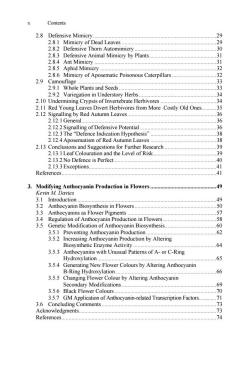
Contents 2.8 Defensive Mimicry. 39 2.8.1 Mimicry of Dead Leaves.. .29 2.8.2 Defensive Thorn Automimicry 2.8.3 Defensive Animal Mimicry by Plants 31 2.8.4 Ant Mimicry.. 31 2.8.5 Aphid Mimicry 32 2.8.6 Mimicry of Aposematic Poisonous Caterpillars 32 2.9 Camouflage 33 2 9 1 Whole Plants and Seeds 33 2 9 2 variegation in Understory herbs 34 2.10 Undermining Crypsis of Invertebrate Herbivores 34 2.11 Red Young Leaves Divert Herbivores from More Costly Old Ones. 2.12 Signalling by Red Autumn Leaves 36 2 12 I General 36 2 12 2 Signalling of Defensive potential 16 2.12.3 The "Defence Indication Hypothesis" 2.12.4 Aposematism of Red Autumn Leaves 18 2.13 Conclus and Su for Further Research 10 2 13.1Leaf Coloura n and the level of risk 20 2 13.2No Defer ce is Perfec Ref rences 3.Modifyi .49 oductior .3 49 Anthocyanin Biosynthesis in Flowers Anthocyanins as Flower Pigments Regulation of Anthocyanin Production in Flowers Genetic Modification of Anthocyanin Biosynthesis.. .60 3.5.1 Preventing Anthocyanin Production. .62 3.5.2 Increasing Anthocyanin Production by Altering Biosynthetic Enzyme Activity... .6d 3.5.3 Anthocyanins with Unusual Patterns of A-or C-Ring Hvdroxvlation.. .65 3.5.4 Generating New Flower Colours by Altering Anthocyanin B-Ring Hydroxylation 66 3.5.5 Changing Flower Colour by Altering Anthocyanin Secondary Modifications. 69 3.5.6 Black Flower Colours. 70 3.5.7 GM Application of Anthocyanin-related Transcription Factors. 71 3.6 Concluding Comments 73 Acknowledgments.. 73 References. 74
x Contents 2.8 Defensive Mimicry......................................................................................29 2.8.1 Mimicry of Dead Leaves ..................................................................29 2.8.2 Defensive Thorn Automimicry .........................................................30 2.8.3 Defensive Animal Mimicry by Plants...............................................31 2.8.4 Ant Mimicry .....................................................................................31 2.8.5 Aphid Mimicry .................................................................................32 2.8.6 Mimicry of Aposematic Poisonous Caterpillars ...............................32 2.9 Camouflage .................................................................................................33 2.9.1 Whole Plants and Seeds....................................................................33 2.9.2 Variegation in Understory Herbs ......................................................34 2.10 Undermining Crypsis of Invertebrate Herbivores .......................................34 2.11 Red Young Leaves Divert Herbivores from More Costly Old Ones..........35 2.12 Signalling by Red Autumn Leaves..............................................................36 2.12.1 General..............................................................................................36 2.12.2 Signalling of Defensive Potential .....................................................36 2.12.3 The “Defence Indication Hypothesis” ..............................................38 2.12.4 Aposematism of Red Autumn Leaves ..............................................38 2.13 Conclusions and Suggestions for Further Research ....................................39 2.13.1 Leaf Colouration and the Level of Risk............................................39 2.13.2 No Defence is Perfect .......................................................................40 2.13.3 Exceptions.........................................................................................41 References............................................................................................................41 3. Modifying Anthocyanin Production in Flowers ..............................................49 Kevin M. Davies 3.1 Introduction .................................................................................................49 3.2 Anthocyanin Biosynthesis in Flowers .........................................................50 3.3 Anthocyanins as Flower Pigments ..............................................................57 3.4 Regulation of Anthocyanin Production in Flowers .....................................58 3.5 Genetic Modification of Anthocyanin Biosynthesis....................................60 3.5.1 Preventing Anthocyanin Production .................................................62 3.5.2 Increasing Anthocyanin Production by Altering Biosynthetic Enzyme Activity ..........................................................64 3.5.3 Anthocyanins with Unusual Patterns of A- or C-Ring Hydroxylation ...................................................................................65 3.5.4 Generating New Flower Colours by Altering Anthocyanin B-Ring Hydroxylation ......................................................................66 3.5.5 Changing Flower Colour by Altering Anthocyanin Secondary Modifications ..................................................................69 3.5.6 Black Flower Colours .......................................................................70 3.5.7 GM Application of Anthocyanin-related Transcription Factors.............71 3.6 Concluding Comments ................................................................................73 Acknowledgments................................................................................................73 References............................................................................................................74

Contents XI 4.Prevalence and Functions of Anthocyanins in Fruits .85 luction 85 43 Prevalence of Fruit Colours. 4 Distribution of Anthocyanins in Fruit 4. Environmental Regulation of Colour Development.. 4.5.1 Light. 4.5.2 Temperature 4.5.3 Other Factors. 9 4.6 Anthocyanins in Attraction. .,92 4.6.I Visual Svstems. 92 4.62 Red Fruits 95 4.6.3 Blue and Black Fruits 94 4.7 Fruit Quality and Composition .95 4.7.1 Health Benefits. .95 4.7.2 Nutritional Content and Defensive Strength .96 473 Maturity .97 4.8 Anthocyanin and Fruit Size 98 49 Photoprotection. 99 4.10 Perspectives. 99 References 100 5.Anthocyanin Biosynthesis in Plant Cell Cultures: A potential souree of natural colourants 107 Simon Deroles 5.1 Introduction 107 5.1.1 The Anth 10 5.1.2 Plant Cell Cult 52 D 111 52.1T 522 pes of Ar 523 erases from Carrot Cell Cultures 112 54 525 s(Carbon,Nitrogen,Phosphate) 526 ation 527 5.2.8 ght 529 Aggregate Size trategies for Enhanced Production of Anthocyanins. 5.3 Vitis vinifera (Grape). 118 5.3.1 Types of Anthocyanins. 5.32 Modification of Anthocyanins in Grape Cell Cultures 11y 5.33 Phytohormones 5.34 Nutrients (Carbon. Nitrogen,Phosphate).. .120 53.5 pH,Conditioned Media and Feeder Layers. 122 5.3.6 Elicitation and Light.. .122
Contents xi 4. Prevalence and Functions of Anthocyanins in Fruits .....................................85 W. J. Steyn 4.1 Introduction .................................................................................................85 4.2 Prevalence of Fruit Colours.........................................................................86 4.3 Developmental Patterns...............................................................................88 4.4 Distribution of Anthocyanins in Fruit..........................................................89 4.5 Environmental Regulation of Colour Development ....................................89 4.5.1 Light..................................................................................................90 4.5.2 Temperature......................................................................................90 4.5.3 Other Factors.....................................................................................91 4.6 Anthocyanins in Attraction..........................................................................92 4.6.1 Visual Systems..................................................................................92 4.6.2 Red Fruits..........................................................................................93 4.6.3 Blue and Black Fruits........................................................................94 4.7 Fruit Quality and Composition....................................................................95 4.7.1 Health Benefits .................................................................................95 4.7.2 Nutritional Content and Defensive Strength .....................................96 4.7.3 Maturity ............................................................................................97 4.8 Anthocyanin and Fruit Size.........................................................................98 4.9 Photoprotection ...........................................................................................98 4.10 Perspectives.................................................................................................99 References..........................................................................................................100 5. Anthocyanin Biosynthesis in Plant Cell Cultures: A Potential Source of Natural Colourants .....................................................107 Simon Deroles 5.1 Introduction ...............................................................................................107 5.1.1 The Anthocyanins...........................................................................107 5.1.2 Plant Cell Cultures..........................................................................109 5.2 Daucus carota (Carrot)..............................................................................111 5.2.1 Types of Anthocyanins ...................................................................111 5.2.2 Glucosyltransferases from Carrot Cell Cultures .............................111 5.2.3 Phytohormones ...............................................................................112 5.2.4 GA3 .................................................................................................113 5.2.5 Nutrients (Carbon, Nitrogen, Phosphate)........................................114 5.2.6 Elicitation........................................................................................115 5.2.7 Light................................................................................................116 5.2.8 Aggregate Size................................................................................117 5.2.9 Future Strategies for Enhanced Production of Anthocyanins .........117 5.3 Vitis vinifera (Grape).................................................................................118 5.3.1 Types of Anthocyanins ...................................................................119 5.3.2 Modification of Anthocyanins in Grape Cell Cultures ...................119 5.3.3 Phytohormones ...............................................................................119 5.3.4 Nutrients (Carbon, Nitrogen, Phosphate)........................................120 5.3.5 pH, Conditioned Media and Feeder Layers ....................................122 5.3.6 Elicitation and Light .......................................................................122
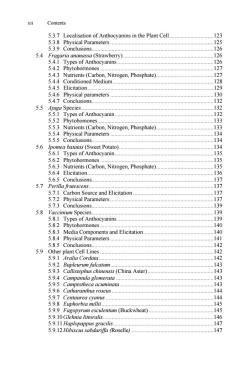
xii Contents 5.3.7 Localisation of Anthocyanins in the Plant Cell.. .123 5.3.8 Physical Parameters. ..125 539 Conclusions .126 5.4 Fragaria ananassa(Strawberry) 126 5.4.1 Types of Anthocyanins .126 5.4.2 Phytohormones 127 5.4.3 Nutrients(Carbon,Nitrogen,Phosphate) 127 544 Conditioned Medium 128 5 4 5 Elicitation 129 5 4 6 Physical parameters .130 54.7 Conclusions. 13 5.5 Aiuga species 132 5.5.1 Types of Anthocyanin. 13 132 5.5.3 Nutrients(Carbon,Nitrogen,Phosphate). 111 5 54 Physical Parameters 124 5.5.5 Conclusions 114 5.6 hatatas (Sweet Potato 134 561 T s of Anthocyanin 139 56) 135 ts (Carbon,Nitrogen,Phosphate) 139 56A 136 5.6.5c on 13 57 137 571 arbon S urce and Elicitation rameters. 5.7.3 5.8 ac ium Spe 582 ype 584 Media Components and Elicitation. 140 Physical Parameters .4 5.8.5 Conclusions. …142 5.9 Other plant Cell Lines .142 Aralia Cordata .142 5.92 Bupleurum falcatum. .143 5.9.3 Callistephus chinensis (China Aster).... ..143 5.9.4 Campanula glomerata .143 5.9.5 Camptotheca acuminata 143 5 9 6 Catharanthus roseus. 144 5.9.7 Centaurea cyanus. 144 5.9.8 Euphorbia millii ..145 5.9.9 Fagopyrum esculentum(Buckwheat) .45 5.9.10 Glehnia littoralis.. .146 5.9.11 Haplopappus gracilis. 147 5.9.12 Hibiscus sabdariffa (Roselle) .147
xii Contents 5.3.7 Localisation of Anthocyanins in the Plant Cell...............................123 5.3.8 Physical Parameters ........................................................................125 5.3.9 Conclusions.....................................................................................126 5.4 Fragaria ananassa (Strawberry)...............................................................126 5.4.1 Types of Anthocyanins ...................................................................126 5.4.2 Phytohormones ...............................................................................127 5.4.3 Nutrients (Carbon, Nitrogen, Phosphate)........................................127 5.4.4 Conditioned Medium ......................................................................128 5.4.5 Elicitation........................................................................................129 5.4.6 Physical parameters ........................................................................130 5.4.7 Conclusions.....................................................................................132 5.5 Ajuga Species ............................................................................................132 5.5.1 Types of Anthocyanin.....................................................................132 5.5.2 Phytohomones.................................................................................133 5.5.3 Nutrients (Carbon, Nitrogen, Phosphate)........................................133 5.5.4 Physical Parameters ........................................................................134 5.5.5 Conclusions.....................................................................................134 5.6 Ipomea batatas (Sweet Potato)..................................................................134 5.6.1 Types of Anthocyanin.....................................................................135 5.6.2 Phytohormones ...............................................................................135 5.6.3 Nutrients (Carbon, Nitrogen, Phosphate)........................................135 5.6.4 Elicitation........................................................................................136 5.6.5 Conclusions.....................................................................................137 5.7 Perilla frutescens.......................................................................................137 5.7.1 Carbon Source and Elicitation ........................................................137 5.7.2 Physical Parameters ........................................................................137 5.7.3 Conclusions.....................................................................................139 5.8 Vaccinium Species.....................................................................................139 5.8.1 Types of Anthocyanins ...................................................................139 5.8.2 Phytohormones ...............................................................................140 5.8.3 Media Components and Elicitation.................................................140 5.8.4 Physical Parameters ........................................................................141 5.8.5 Conclusions.....................................................................................142 5.9 Other plant Cell Lines ...............................................................................142 5.9.1 Aralia Cordata................................................................................142 5.9.2 Bupleurum falcatum........................................................................143 5.9.3 Callistephus chinensis (China Aster)..............................................143 5.9.4 Campanula glomerata ....................................................................143 5.9.5 Camptotheca acuminata .................................................................143 5.9.6 Catharanthus roseus.......................................................................144 5.9.7 Centaurea cyanus ...........................................................................144 5.9.8 Euphorbia millii..............................................................................145 5.9.9 Fagopyrum esculentum (Buckwheat) .............................................145 5.9.10 Glehnia littoralis.............................................................................146 5.9.11 Haplopappus gracilis......................................................................147 5.9.12 Hibiscus sabdariffa (Roselle) .........................................................147
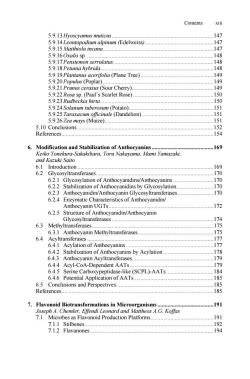
Contents 147 is sp 148 Penstemon serrulatus 14 148 5.9.19 Plantans acerifolia(Plane Tree). .4 5.9.20 Populus (Poplar) .14 5.9.21 Prunus cerasus (Sour Cherry) .149 5.9.22 Rosa sp.(Paul's Scarlet Rose) .5 5.9.23 Rudbeckia hirta.. 5.9.24 Solanum tuberosum (Potato) 151 5.9.25 Taraxacum officinale (Dandelion) 15 5.9.26 Zea mays (Maize).. 151 5.10 Conclusions. .52 References 154 6.Modification and Stabilization of Anthocyanins .169 Keiko Yonekura-Sakakibara.Toru Nakavama.Mami Yamazaki and ka=uki Saito 6 1 Introduction 16q 6.2 170 vanidins/Anthocvanins 170 6)) Stabilization of anthocyanidins by Glycosylation 17d 6.2.3 Anthocyanidin/Anthocyanin Glycosyltransferases 170 natic Characteristics of antho vanidin A nth 172 6.2.5 ctur e of Anth yanidin/Anthocyanin ans 174 6.3 Methyltra 179 631 nin Methyltransferases 6.4 lati of Anthocyanins 177 yanins by Acylation cyanin Acyl 6.4.4 64 Acyl-CoA Depende ine oxypeptid (SCPL)-AATs 77788 6.4.6 Potentia n o of AAT 6.5 Conc usions and Perspectives References. 7.Flavonoid Biotransformations in Microorganisms. .191 Joseph A.Chemler.Effendi Leonard and Mattheos A.G.Koffas 7.1 Microbes as Flavonoid Production Platforms.. 191 7.1.I Stilbenes. .192 7.1.2 Flavanones .194
Contents xiii 5.9.13 Hyoscyamus muticus.......................................................................147 5.9.14 Leontopodium alpinum (Edelweiss)................................................147 5.9.15 Matthiola incana.............................................................................147 5.9.16 Oxalis sp. ........................................................................................148 5.9.17 Penstemon serrulatus......................................................................148 5.9.18 Petunia hybrida...............................................................................148 5.9.19 Plantanus acerifolia (Plane Tree)...................................................149 5.9.20 Populus (Poplar) .............................................................................149 5.9.21 Prunus cerasus (Sour Cherry).........................................................149 5.9.22 Rosa sp. (Paul’s Scarlet Rose) ........................................................150 5.9.23 Rudbeckia hirta...............................................................................150 5.9.24 Solanum tuberosum (Potato)...........................................................151 5.9.25 Taraxacum officinale (Dandelion)..................................................151 5.9.26 Zea mays (Maize)............................................................................151 5.10 Conclusions ...............................................................................................152 References..........................................................................................................154 6. Modification and Stabilization of Anthocyanins ...........................................169 Keiko Yonekura-Sakakibara, Toru Nakayama, Mami Yamazaki, and Kazuki Saito 6.1 Introduction ...............................................................................................169 6.2 Glycosyltransferases..................................................................................170 6.2.1 Glycosylation of Anthocyanidins/Anthocyanins ............................170 6.2.2 Stabilization of Anthocyanidins by Glycosylation..........................170 6.2.3 Anthocyanidin/Anthocyanin Glycosyltransferases.........................170 6.2.4 Enzymatic Characteristics of Anthocyanidin/ Anthocyanin UGTs .........................................................................172 6.2.5 Structure of Anthocyanidin/Anthocyanin Glycosyltransferases .......................................................................174 6.3 Methyltransferases.....................................................................................175 6.3.1 Anthocyanin Methyltransferases.....................................................175 6.4 Acyltransferases ........................................................................................177 6.4.1 Acylation of Anthocyanins .............................................................177 6.4.2 Stabilization of Anthocyanins by Acylation ...................................178 6.4.4 Acyl-CoA-Dependent AATs ..........................................................179 6.4.5 Serine Carboxypeptidase-like (SCPL)-AATs .................................184 6.4.6 Potential Application of AATs .......................................................185 6.5 Conclusions and Perspectives....................................................................185 References..........................................................................................................185 7. Flavonoid Biotransformations in Microorganisms .......................................191 Joseph A. Chemler, Effendi Leonard and Mattheos A.G. Koffas 7.1 Microbes as Flavonoid Production Platforms............................................191 7.1.1 Stilbenes..........................................................................................192 7.1.2 Flavanones ......................................................................................194 6 .4. 3 Anthocyanin Acyltransferases.........................................................179
按次数下载不扣除下载券;
注册用户24小时内重复下载只扣除一次;
顺序:VIP每日次数-->可用次数-->下载券;
- 单宁化学(书籍文献)Tannin Chemistry.pdf
- 绍兴文理学院:化学化工学院高分子材料与工程专业课程教学大纲汇编.pdf
- 绍兴文理学院:化学化工学院化学专业课程教学大纲汇编.pdf
- 绍兴文理学院:化学化工学院应用化学专业课程教学大纲汇编.pdf
- 三明学院:资源与化工学院材料化学专业课程教学大纲汇编.pdf
- 三明学院:材料化学专业课程教学大纲汇编.pdf
- 三明学院:化学工程与工艺专业课程教学大纲汇编.pdf
- 《药物化学》课程文献资料(Medicinal Chemistry)Selective inhibition of BET bromodomains.pdf
- 《药物化学》课程文献资料(Medicinal Chemistry)Personalized medicine in oncology - the future is now.pdf
- 《药物化学》课程文献资料(Medicinal Chemistry)GLIVEC(STI571, IMATINIB),A RATIONALLY DEVELOPED,TARGETED ANTICANCER DRUG,Nat Rev Drug Disc 2002.pdf
- 《药物化学》课程文献资料(Medicinal Chemistry)Epigenetic protein families - a new frontier for drug discovery.pdf
- 《药物化学》课程文献资料(Medicinal Chemistry)Application of the Three-Dimensional Structures of Protein Target Molecules in Structure-Based Drug Design.pdf
- 《药物化学》课程文献资料(Medicinal Chemistry)Structural Mechanism for Statin Inhibition of HMG-CoA Reductase.pdf
- 《药物化学》课程文献资料(Medicinal Chemistry)Structural basis for inhibition of a voltage-gated Ca2+ channel by Ca2+ antagonist drugs.pdf
- 《药物化学》课程文献资料(Medicinal Chemistry)Prioritization of cancer therapeutic targets using CRISPR–Cas9 screens.pdf
- 《药物化学》课程文献资料(Medicinal Chemistry)Discovery of a selective inhibitor of oncogenic B-Raf kinase with potent antimelanoma activity.pdf
- 《药物化学》课程文献资料(Medicinal Chemistry)Clinical efficacy of a RAF inhibitor needs broad target blockade in BRAF-mutant melanoma.pdf
- 《药物化学》课程文献资料(Medicinal Chemistry)Name of common cyclic compounds.docx
- 中国科学技术大学:《药物化学》课程教学资源(PPT课件讲稿)Chapter 5 癌症 Cancer(2/2).ppt
- 中国科学技术大学:《药物化学》课程教学资源(PPT课件讲稿)Chapter 7 作用神经系统的药物(中枢神经系统 CNS).ppt
- 山东第一医科大学(泰山医学院):《基础化学》课程教学资源(教案大纲,打印版)理论教学大纲(负责人:董建).pdf
- 山东第一医科大学(泰山医学院):《基础化学》课程教学资源(教案大纲,打印版)基础化学实验教案.pdf
- 山东第一医科大学(泰山医学院):《基础化学》课程教学资源(习题与解析,打印版)绪论.pdf
- 山东第一医科大学(泰山医学院):《基础化学》课程教学资源(习题与解析,打印版)缓冲溶液.pdf
- 山东第一医科大学(泰山医学院):《基础化学》课程教学资源(习题与解析,打印版)电解质溶液.pdf
- 山东第一医科大学(泰山医学院):《基础化学》课程教学资源(习题与解析,打印版)多相离子平衡.pdf
- 山东第一医科大学(泰山医学院):《基础化学》课程教学资源(习题与解析,打印版)化学反应速率.pdf
- 山东第一医科大学(泰山医学院):《基础化学》课程教学资源(习题与解析,打印版)化学热力学基础.pdf
- 山东第一医科大学(泰山医学院):《基础化学》课程教学资源(习题与解析,打印版)稀溶液的依数性.pdf
- 山东第一医科大学(泰山医学院):《基础化学》课程教学资源(习题与解析,打印版)电极电位.pdf
- 山东第一医科大学(泰山医学院):《基础化学》课程教学资源(习题与解析,打印版)原子结构.pdf
- 山东第一医科大学(泰山医学院):《基础化学》课程教学资源(习题与解析,打印版)分子结构.pdf
- 山东第一医科大学(泰山医学院):《基础化学》课程教学资源(习题与解析,打印版)配位化合物结构.pdf
- 山东第一医科大学(泰山医学院):《基础化学》课程教学资源(习题与解析,打印版)滴定分析法.pdf
- 山东第一医科大学(泰山医学院):《基础化学》课程教学资源(习题与解析,打印版)分光光度分析.pdf
- 山东第一医科大学(泰山医学院):《基础化学》课程教学资源(实验指导,打印版)基础化学实验基本常识.pdf
- 山东第一医科大学(泰山医学院):《基础化学》课程教学资源(实验指导,打印版)误差分析及数据处理.pdf
- 山东第一医科大学(泰山医学院):《基础化学》课程教学资源(实验指导,打印版)部分溶液的配制.pdf
- 山东第一医科大学(泰山医学院):《基础化学》课程教学资源(实验指导,打印版)粗食盐的提纯与检验.pdf
- 山东第一医科大学(泰山医学院):《基础化学》课程教学资源(实验指导,打印版)EDTA标准溶液的配制、标定及水的总硬度测定.pdf
